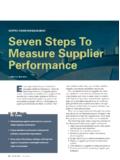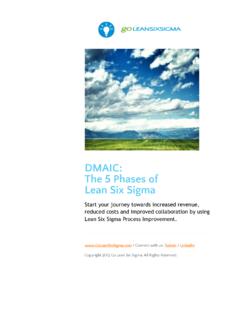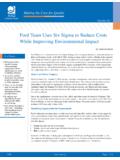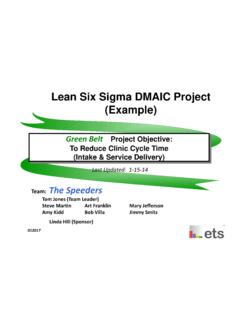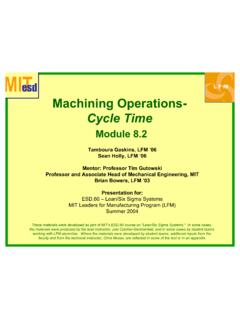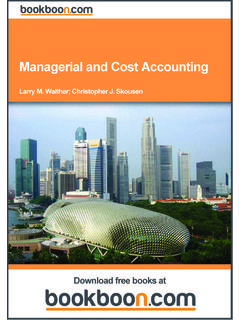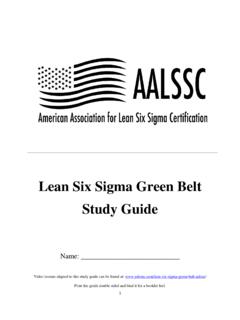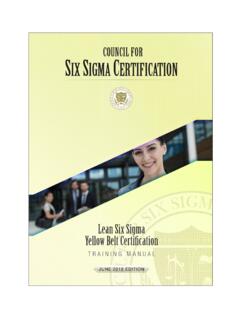Transcription of LEAN/Six Sigma Concepts & Principles
1 *All documents are property of Curis Consulting. Do not duplicate or distribute without written Sigma Concepts & Principles Jennifer Calohan, RN, TQMP, PCMH-CCEP rincipal ConsultantCURIS Consulting*All documents are property of CurisConsulting. Do not duplicate or distribute without written Principles What Does it Mean? The term lean transformation is used to characterize a company moving from an old way of thinking to lean thinking . lean is about creating the most value for the customer while minimizing waste. A lean approach is about understanding what s really going on, and improving the processes by which products and services are created and delivered. *All documents are property of CurisConsulting. Do not duplicate or distribute without written is --- About doing morewith less , but Doing more productive work with less effort and waste NOT about doingmore work with lessresources!*All documents are property of CurisConsulting.
2 Do not duplicate or distribute without written Sigma is --- Six Sigma is shorthand for a discipline that allows any business to design, improve and manage its processes so that they perform at their highest possible levels. High levels of performance mean high volume, fast turnaround times, very few errors or defects and low cost. Effective and efficient processes also help to reduce staff turnover and increase retention by eliminating one of the main causes of high turnover cumbersome and complex procedures and *All documents are property of CurisConsulting. Do not duplicate or distribute without written + SIX Sigma = lean SIX Sigma *All documents are property of CurisConsulting. Do not duplicate or distribute without written the Balance*All documents are property of CurisConsulting. Do not duplicate or distribute without written Terms/Tools Kaizen: change for better model ofcontinuousimprovement Gemba: real place the place where value iscreated Gemba Walk: walking through the Gemba toperformcurrent stateassessment VOC: Voice of theCustomer 5-S: organization sort, straighten,shine,standardize,sustain 5 Why s root cause analysis A3: a structured problem solving andcontinuousimprovementapproach/tool PDSA: tool for process improvement toincrementallytest and measurechange DMAIC: quality improvementmethodology*All documents are property of CurisConsulting.
3 Do not duplicate or distribute without written Part Philosophy ~ Part Action Plan*All documents are property of CurisConsulting. Do not duplicate or distribute without written Model & Strategy Kaizen (Continuous Improvement) is a strategy where employees at all levels of the company work together proactively to achieve regular, incremental improvements Kaizen works hand-in-handwith StandardizedWork Kaizen is about organizing events focused on improving specific areas within the company. These events involve teams of employees at all levels, with an especially strong emphasis on involving front line employees*All documents are property of CurisConsulting. Do not duplicate or distribute without written Steps of the Gemba Walk4. Where? Be sure to observe in the area where the work is done and value is created5. Who/What? Focus on observing processes and take notice of the quality of theservice(s) inputs& Identify the Purpose forthe Be sure to understandtheprocess to Identify a specifictime(s) toobserve*All documents are property of CurisConsulting.
4 Do not duplicate or distribute without written Steps of the Gemba Take notice of how the process functions in the current state (separate people from process) Observe and identify the gap between the ideal state and what is occurring in Identify opportunities for improvement (with theend goal being: closure of the gap between ideal & currentstate)*All documents are property of CurisConsulting. Do not duplicate or distribute without written the Gemba Walk IS & IS NOTG emba Walk ISto: Observe UnderstandFocus onProcess Ask Questions Engage People LearnBeTransparentGemba Walk is NOTto: JudgePlace Blame Focus onPeopleMake Assumptions Define Specific Problem Launch into ImprovementActivities*All documents are property of CurisConsulting. Do not duplicate or distribute without written 5S*All documents are property of CurisConsulting. Do not duplicate or distribute without written Tool*All documents are property of CurisConsulting.
5 Do not duplicate or distribute without written Cycles for Improvement ThePlan-Do-Study-Act(PDSA)cycleispartoft heInstituteforHealthcareImprovement(IHI) ModelforImprovement Simple yet powerful tool for accelerating improvement. Essential to remember if we can t measure it we can t improveit! Always start with baseline measurements, decide on metrics for success, and remember to re-measure to determine course of *All documents are property of CurisConsulting. Do not duplicate or distribute without written Example*All documents are property of CurisConsulting. Do not duplicate or distribute without written Your Quality Improvement Program Definition We all have our own idea ofwhat Quality Improvement is (or should be)inour has it been defined and agreedupon? According to AAFP Quality improvement (QI) is a systematic, formal approach totheanalysis of practice performance and efforts to improveperformance. To ensure its success, your QI Program should be defined through methodology, an assessment processand should incorporate an accountabilitymatrix.
6 *All documents are property of CurisConsulting. Do not duplicate or distribute without written permission.*All documents are property of CurisConsulting. Do not duplicate or distribute without written permission.*All documents are property of CurisConsulting. Do not duplicate or distribute without written Methodology -DMAIC*All documents are property of CurisConsulting. Do not duplicate or distribute without written 1 -Define Definethe Problem or Opportunity What do we see as the issue in need of improvement? It may be the problem or it may be a symptom of an underlying problem. Declare it with a problem statement. Definethe Impact How severe is the issue? What is the impact on clinical, operational, financial or quality performance? What is the impact to our internal teams? What is the impact to our patients/customers? Definethe Target or Goal Declare your goal with a statement that is reflective of your problem statement.
7 Be certain that your goals are SMART (specific, measurable, achievable, relevant, timebound). Determine your Metrics for Success what metrics will indicate success? Definethe Process/Scope Determine the process to be improved, the high level scope and the appropriate resources to involve Definethe Customer(s) Determine your customers and their needs, requirements, expectations Voice of the Customer*This step requires the team to have access to some baseline data. There will be a problem statement developed and a charter created for the scope of the project/work.*All documents are property of CurisConsulting. Do not duplicate or distribute without written & Define the Customer We must define the customersof: The healthcare delivery system as awhole Each process being targeted forimprovement We must identify each customeras: InternalCustomers ExternalCustomersWe must incorporate the Voice of the Customer(VOC)into everyprocess!
8 !*All documents are property of CurisConsulting. Do not duplicate or distribute without written Charter (Step 1 Define)Project CharterSampleImpact/ Business Case Why should you do this project/improvement work? What are the anticipated benefits of doing this work?Problem Statement What is the problem/issue/concern Goal What are the targets/goals associated with this work?Metrics What are the primary metrics to be used? What are the secondary metrics to be used?Scope of Work What processes are being included in this work? What processes are not being included in this work?Team Who is the executive sponsor? Who is the leader? Who are the team members? What are the roles and responsibilities associated with each team member related to the scope of work?Plan How will this project be conducted? When will this project be completed? REFER TO DMAIC STEPSC ommunication When, where and how will the team meet? How will communication be facilitated?
9 How often will updates be reported to leadership/exec sponsor?*All documents are property of CurisConsulting. Do not duplicate or distribute without written 2 Measure Measurethe current state (process map) Measurethe waste associated with the process Measurethe performance related to the process Measureactual and potential barriers *This is your data collection step once data is collected and documented, remember to continue to remeasure and refine your data throughout the process!*Update your charter once you have validated your baseline data!*All documents are property of CurisConsulting. Do not duplicate or distribute without written We Can t Measure it We Can t Improve it! Essential to remember if we can t measure it we can t improveit! Always start with baseline measurements, decide on metrics for success, and remember to re-measure to determine course of plans to incrementally improve working toward future state.
10 Strategies to improve remeasuring along the success, reassess, continuously improve!*All documents are property of CurisConsulting. Do not duplicate or distribute without written Tool Failure Mode & Effects Analysis*All documents are property of CurisConsulting. Do not duplicate or distribute without written Barriers Potential & Actual*All documents are property of CurisConsulting. Do not duplicate or distribute without written 3 Analyze Analyzethe problem/process Root Cause Analysis 5 Why s Analyzecause and effect May use Fishbone Diagram Analyzethe data Analyzethe waste and or value stream*Continue to document your progress, update your charter and remeasure as appropriate.*All documents are property of CurisConsulting. Do not duplicate or distribute without written 3 Root Cause Analysis & 5 Why s*All documents are property of CurisConsulting. Do not duplicate or distribute without written of the 5 Whys Help identify the root cause of aproblem.
